 |
|
 12-04-2009, 09:46 AM
12-04-2009, 09:46 AM
|
#1
|
|
Admiral
Join Date: Oct 2004
Posts: 3,067
|
The latest boat (SV Pelican) to be abandoned in the ARC rally is reported to have suffered an undisclosed standing rigging problem, this problem was to be then compounded by getting a 'line' round the prop, see link HERE
Thought this might be a good subject to gather ideas and solutions how to remove rope, line, nets or plastic bags etc.. from a sail boat's propeller.
Assuming the above boat is some 400 miles offshore in 6ft seas - blue skies - 10 kt wind - sails are down, 5 adult fit crew on board :- a length of running rigging line has rapped round the prop shaft - stopping the engine.
What is the first thing to do?
What is the second?
What is the third?
What next?
__________________

|

|

|
 12-04-2009, 10:22 AM
12-04-2009, 10:22 AM
|
#2
|
|
Ensign
Join Date: Dec 2007
Posts: 23
|

Quote:
Originally Posted by MMNETSEA

The latest boat (SV Pelican) to be abandoned in the ARC rally is reported to have suffered an undisclosed rigging problem, this problem was to be then compounded by getting a 'line' round the prop, see link HERE
Thought this might be a good subject to gather ideas and solutions how to remove rope, line, nets or plastic bags etc.. from a sail boat's propeller.
Assuming the above boat is some 400 miles offshore in 6ft seas - blue skies - 10 kt wind - sails are down, 5 adult fit crew on board :- a length of running rigging line has rapped round the prop shaft - stopping the engine.
What is the first thing to do?
Hmmm . . . . first thing - avoid the problem - iron clad rule - don't start the engine unless all ropes have been cleared from the water.
What is the second?
Hmmm . . . . second thing - avoid the problem - fit rope cutters to the shaft.
What is the third?
Hmmm . . . . third thing - avoid the problem - pay attention - you can usually hear a rope starting to wrap and if you immediately switch to neutral perhaps a little reverse, can often avoid a wrap
What next?
Fourth . . . pull on the rope  Pop the transmission into reverse and pull, pop the transmission back and forth between reverse and forward and pull.
Fifth . . . sail to harbour - it is a sail boat right Pop the transmission into reverse and pull, pop the transmission back and forth between reverse and forward and pull.
Fifth . . . sail to harbour - it is a sail boat right
Sixth . . . if it is calm jump over the side and cut the rope loose - tie a rope to the person in the water so you don't end up with a MOB |
__________________
__________________
|

|

|
 12-04-2009, 11:10 AM
12-04-2009, 11:10 AM
|
#3
|
|
Commander
Join Date: Sep 2009
Posts: 151
|

Well, this is how an inexperienced skipper would attack the problem:
(I take it as my first lesson on jury rigging
First, sails are down. All of them? This would mean more serious problem than just a running rigging line wrapped around the prop.
I would first try to set some sails enough to be in line with waves. As I see at weather report, at that time the waves might ran diagonally to the wind,
which means a comfortable roomy run, but in a wildly different direction we want to go. However now we are doing damage control, so it is okay (and the waves will turn into the wind within a day anyway). Of course if the backstay or port want (what is the proper word? we call it "vantni") would be lost, I would pick the other direction, until something is put in place.
It is hard to imagine that there is no running line left to elevate a sail on the mast. Any sail would do. Still if this would be a case, there are several alternatives to get a rope up there (or use spiboom for elevation), and set any sail. If the sail area is too big, just knot a rope around it.
Cutting the line wrapped around the prop would be the second step, if it is not in the way of setting the sail/steering. If it is, would just make efforts to take it out of way, and set direction with sail/steering. When the direction is ready, next step would be getting the line off the prop. I figure it would be hard but doable in 2m seas, and with minimal speed enough to steer (inexperienced skipper here), but if it isn't, I would just move on to make the rigging suitable to get full sail.
__________________
|

|

|
 12-04-2009, 10:25 PM
12-04-2009, 10:25 PM
|
#4
|
|
Admiral
Join Date: Oct 2004
Posts: 3,067
|
The First thing to do :-
The Standing rigging is the safety problem, it requires to be stabilized and made safe so that the spars don't fall.
Once that is achieved, only then the line round the prop problem can be addressed, at that point there will be no requirement to raise a sail because crew will be required to enter the water - having the boat moving would make it very difficult to work on the prop problem.
__________________

|

|

|
 12-05-2009, 04:47 AM
12-05-2009, 04:47 AM
|
#5
|
|
Moderator
Join Date: Jun 2007
Home Port: Washington DC
Vessel Name: SV Mahdee
Posts: 3,236
|

Let's see...off the top of my head...here are some thoughts:
Well, put the engine in neutral and shut it off asap. We've had a few experiences wrapping a pick up line on our fore-and-aft mooring (with our other boat) and know that getting the prop stopped asap really increases the likelihood of a successful removal of a line. A previous poster mentions that you can tell when you're wrapping something, and yes, that's true!
We don't have one of those sharp cutter do-hicky things on the prop, so if it gets wrapped, it gets wrapped. We have a well protected prop aperture, though.
We've never wrapped running rigging around the prop...but if we had access to the free end of the running rigging, we might have someone try to hand turn (from the inside of the boat) the prop shaft while someone else tries to pull on the line. We would not use the engine to try and free the line.
If the standing rigging problem is quickly fixable--fix it or affect a temporary rig and continue sailing, worry about the prop when you get to a port or when the wind dies on you. If not--
After stabilizing/fixing/whatever the standing rigging, one still has to consider seas/winds and whether it would be best to heave to rather than bob about like a cork and make way depending upon winds and seas. While I have no experience diving on a boat in 6 ft seas, that whole rolling about/bobbing bit that will happen if no sails are raised at all makes me think that on our (full keel) boat, we'd try to heave to before someone tries to get whatever it is off the prop. If whatever was wrong with the standing rigging precludes heaving to...well then we wouldn't do it.
Having no real idea how to get something off our prop w/o diving on the boat, we'd be likely to have the best swimmer/diver aboard go over the side (with hooka rather than dive tank) and investigate/remove the offending item. David was a competition swimmer and he's a control freak so he'd likely be the fellow to dive on it.
I make the assumption that water temperatures may require a wetsuit or a Lycra at minimum. We'd likely pump up the Tinker Traveler dingy and deploy it alongside the boat since its a piece of cake to get into the Tinker (over the low, pointy bow) when you're in a wetsuit looking like the Michelin Man but a little more difficult to climb our mid-ships deployable swim ladder when you're cold and tired. If its very cold, its nice to have the "back up" of being able to get into the inflatable.
I'd figure that it would be not-too-difficult to get the running rigging unwrapped or just cut it off the prop. David would inspect the prop and stern bearing and I'd check to make sure we hadn't screwed up the prop shaft alignment. We could align the prop if needed but don't know about repairs to the prop itself or the stern bearing if there were problems (can't imagine there would be, though.
If we felt we shouldn't sail, but rather motor to a nearby port to do repairs, we'd motor. If we couldn't motor, or found it too far given our fuel range (1750 nautical miles with full tanks) then...
With all wood spars on this boat, and tools, the spare rigging wire and fittings we carry, there's hardly a thing in our standing rigging that we don't have spares of or can't fix while aboard. I'd think we could fix whatever the sailing problem might be so we wouldn't be having to deal with motoring anyway. If we lost both masts (literally and didn't have parts of them to work with!)...well, as long as we had some of the other spars we'd still be likely to be able to rig something up to sail.
Well that's the off the cuff response...
What would YOU do?
|

|

|
 12-05-2009, 05:50 AM
12-05-2009, 05:50 AM
|
#6
|
|
Commander
Join Date: Sep 2009
Posts: 151
|
Quote:
Originally Posted by redbopeep

I make the assumption that water temperatures may require a wetsuit or a Lycra at minimum.
|
Weather report says ther water temperature is 25C at Cape Verde.
__________________
|

|

|
 12-05-2009, 08:01 AM
12-05-2009, 08:01 AM
|
#7
|
|
Ensign
Join Date: Dec 2007
Posts: 23
|

Quote:
Originally Posted by redbopeep

What would YOU do?
|
This is not a hypothetical - We have had offshore two nets around our prop (off Mexico and half way between South Georgia and St Helena) and one big polypropylene line (off Cape Horn). We do have shaft cutters and they chop up bits of the nets but don't get them off the prop. The cutters usually work very well on line but for some reason this one line melted and fused to the prop and shaft before it got cut off.
In all three cases I thought seriously about going into the water to cut the mess off, but in all three cases I decided that was foolish, and we sailed to harbour and anchored and I cut it then. In one case (between South Georgia and St Helena) we sailed more than 1000miles before we got anchored. I was going to swim if we got a spot with flat seas but we never really did - always had near 2m swells. My concern was I would go in the water and bang my head as the boat bucked in the swell and we would be worse off than before. Since we were sailing well there was absolutely no reason to take that risk.
In this ARC case we don't have any details on the 'rig failure', so it is not at all clear if the better path is to fix the rig or put someone in the water to free the prop. I have gone up the rig several times at sea to fix things and personally I would rather do that than go in the water with a swell running - but neither is fun 
The best answer, as I suggested in my first post, is to avoid the problem - don't start the engine until all lines are cleared from the water, have rope cutters on the shaft, and pay attention and immediately pop the engine in neutral if you hear anything that sounds like a rope hitting the prop.
__________________
|

|

|
 12-05-2009, 01:27 PM
12-05-2009, 01:27 PM
|
#8
|
|
Admiral
Join Date: Jul 2004
Posts: 2,098
|

Evans, I know just what you mean about the risks of going into the water.
The first year of our cruising we were heading across the Mona Passage toward Puerto Rico when we picked up a piece of line by our prop. It was typical Mona Passage annoying - hard on the nose wind, not-nice chop, and I can't say the size of the swell, I wasn't experienced enough then to be able to judge. Peter went over to cut the line, and I remember yelling at him to leave it, just come back! The boat was bucking and bouncing and all I could think of was the hull hitting him on the head and that would have been the end of him.
He got the line pulled off from a trailing end so he didn't have to get close to cut it off, but it was an experience that I obsessed over for months.
We've found that with the two of us alone, mistakes like running rigging going over and getting caught in the prop didn't happen, but when there were others on the boat, lots of stuff found its way overboard. When we were the only two who knew how to sail the boat but we had others on board who wanted to "help", we were sometimes overwhelmed and didn't see things that we would have noticed when alone. And possibly that's what happened with the ARC boat - too many people all expecting somebody else to be paying attention, and possibly not having the experience to understand what they were looking at.
IMO that's no excuse to abandon a boat, though, unless there were something else much more serious threatening them, such as water ingress. (okay, a bit of sexism here ) THEY WERE MEN! They're not supposed to panic and squeal "get me off here, NOW."

|

|

|
 12-05-2009, 03:31 PM
12-05-2009, 03:31 PM
|
#9
|
|
Ensign
Join Date: Dec 2007
Posts: 23
|

Quote:
Originally Posted by JeanneP

Evans, I know just what you mean about the risks of going into the water.
We have had two other offshore 'net/line' experiences. One was more serious, again of Mexico, a big net got caught around our rudder and jammed it/made it very hard to turn. I was not going to close with shore or try to short tack into harbour with the rudder like that. It happened in the middle of the night and I was not going swimming in the dark, but the plan was to cut it off when the sun came up. In the meantime we locked the rudder mid-ships and used the wind vane. Fortunately just before sunrise, the boat speed/motion thru the water pulled the net free and off the boat.
Off Costa Rica we got tangled in miles of mono filament long-line. It would have been a decent day to go swimming - bright sun and flat water- but the long line had big nasty hooks in it every few meters. No way I wanted to go swimming with that mess. We stopped the boat and started pulling pieces of the line up with the boat hook and chopping them up with knives. We freed a sea turtle that had gotten trapped and was still alive. Took us about a half hour of chopping before we got all free, and the shaft cutters did the job to free the prop. I usually feel some remorse about cutting poor fisherman's gear but in this case I felt nothing but glee - especially after seeing the turtle swimming free.
IMO that's no excuse to abandon a boat, though, unless there were something else much more serious threatening them, such as water ingress. (okay, a bit of sexism here ) THEY WERE MEN! They're not supposed to panic and squeal "get me off here, NOW."  Somewhere in the past 10 years the whole ethic has changed, and you one of the very few people on the net that holds to the old standard/ethic (individual responsibility and self-reliance). The new standard/ethic is very much "call 911, wait for outside assistance, insurance will pay for the boat". Even the SSCA salts have changed their tune to this new music. I think this is wrong on so many levels - removes some of the joy and challenge of the sailing life, will inevitably bring more government intervention and restrictions and regulations, and works ok in the Atlantic (and along the US west coast) but just simply will not work in much of the world where rescue facilities are much less available. But I guess it is an inevitable and unstoppable trend, unless something is done to make 'rescue' more difficult in these sort of non-life threatening situations. There is no voice in today's 'safety community' for the self-reliant sailor (avoid the problem or fix the problem).The 'safety community' seems completely focued on rescue gear and not on a strong boat and good seamanship practices to avoid problems and not on tools and materials needed to make at sea repairs.
Somewhere in the past 10 years the whole ethic has changed, and you one of the very few people on the net that holds to the old standard/ethic (individual responsibility and self-reliance). The new standard/ethic is very much "call 911, wait for outside assistance, insurance will pay for the boat". Even the SSCA salts have changed their tune to this new music. I think this is wrong on so many levels - removes some of the joy and challenge of the sailing life, will inevitably bring more government intervention and restrictions and regulations, and works ok in the Atlantic (and along the US west coast) but just simply will not work in much of the world where rescue facilities are much less available. But I guess it is an inevitable and unstoppable trend, unless something is done to make 'rescue' more difficult in these sort of non-life threatening situations. There is no voice in today's 'safety community' for the self-reliant sailor (avoid the problem or fix the problem).The 'safety community' seems completely focued on rescue gear and not on a strong boat and good seamanship practices to avoid problems and not on tools and materials needed to make at sea repairs. |
__________________
|

|

|
 12-05-2009, 07:06 PM
12-05-2009, 07:06 PM
|
#10
|
|
Moderator
Join Date: Jun 2007
Home Port: Washington DC
Vessel Name: SV Mahdee
Posts: 3,236
|

J-
I know exactly what you mean about having to keep an eye on people who "want to help" sailing--things get broken or performed improperly by others unfamiliar with our boat. There are so many things "unfamiliar" to other folks that it is really easier for us to just do it ourselves.
other thoughts--
When thinking about this, one of the reasons I concluded that we'd likely heave to (even though that means your boat IS moving relative to the water) was to keep the bobbing cork of the boat from wacking whoever goes into the water in the head.
I would like ask--has anyone dove on their boat while hove to? Would like to know of experiences with this.
25C=77F...not cold enough that I'd want lycra on but might don it anyway. Typically here in a bay off the Pacific ocean, w have been diving to clean the hull when water temperatures are as high 73F and as low as 58F. When sunny, its warm enough w/o lycra when temps are above about 69F.
Those of you who have disengaged things from your prop--did you check the stern bearing and prop alignment before using the motor again?
I am truly interested in what others have done in this situation. I'm not really interested in "bashing" folks on the ARC for abandoning their boat. Its sad and amazing to learn of boats which are abandoned for what seems like "no reason" to us. However, what is more important is to realize that people can get overwhelmed with things that you or I might find trivial.
Best to all,
|

|

|
 12-06-2009, 02:30 AM
12-06-2009, 02:30 AM
|
#11
|
|
Admiral
Join Date: Oct 2004
Posts: 3,067
|

"Thought this might be a good subject to gather ideas and solutions how to remove rope, line, nets or plastic bags etc.. from a sail boat's propeller.
A length of running rigging line has wrapped round the prop shaft - stopping the engine.
What is the first thing to do?
What is the second?
What is the third?
What next? "
The above resulted in some lively discussion, thanks.
Returning to the question of how to ' remove rope, line, nets or plastic bags etc.. from a sail boat's propeller'
Taking one of the most common type of incident ie.. dinghy's non-floating painter or one of the berthing lines gets sucked under and into the propeller and round the exposed prop shaft. Very quickly it gets wound tighter & tighter until the engine stalls.
Put the engines gearbox into neutral.
Establish the extent of the wrap.
If possible find the loose end of the line - then try turning the propeller by hand in the reverse direction to which it jammed. If that does not work, then try to turn the prop shaft from inside the boat - again in reverse direction.
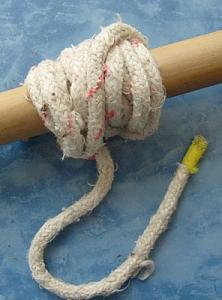
If the above did not work, then collect the appropriate tools to remove the line :- these could
include the following (having used this selection successfully)
Suction Lifter
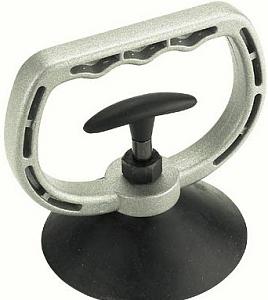
Snorkel Mask
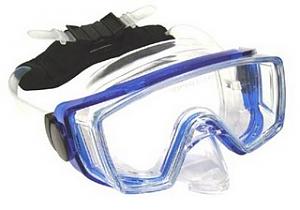
Dive Knife
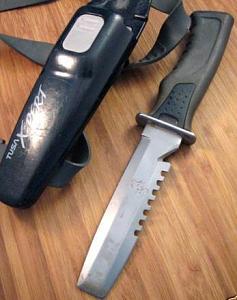
Swiss Army Knife
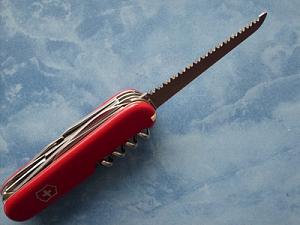
Serrated edge knives
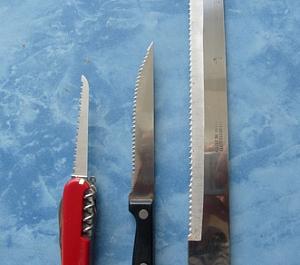
Long nose #6 Vice Grip

The above tools will have individual lanyards.
Consider an appropriate weight belt if necessary.
Also an ordinary Blade Screw Driver around 9" to pry
under lines.
Procedure
Apply the suction lifter to an appropriate position near to prop, then test it - the model pictured above provides well over 150lb pull.
The lanyards of the knife/knives and the vice grips are attached to the suction lifter.
The diver should first pass the loose end of the line over the wrap in the opposite direction to which it was wound until it will not move. At that point start to cut the windings furthest away from loose one. Continue to cut through until all the line is removed.
Assuming that there is another crew member in a dinghy or on deck - the diver should pass the cut wrapped line to the buddy crew.
Note: The knife with serrated edge works much better than the standard sharp edge - sharp point not recommended. The long nose #6 'vice grip' enables the diver to hold individual strands while cutting and also for pulling out lengths that are bound under others.
Have used this procedure in :-
Double Haven - South China Coast to remove fishing net
Outside Rebak Marina - Malaysia to remove 12ft of 4" diameter hawser
Danga Bay anchorage - Malaysia to remove mooring float line
Whitsundays - Queensland - to remove dinghy anchor rode
Singapore Strait - to remove empty 50 kg polyprop fertilizer bag
Durban - South Africa - to remove Surf Rod fishing line
Aceh - Sumatra - to remove plastic bags, just after the Great Tsunami
Used the Suction Lifter to hang onto while giving the hulls a wipe down to remove algae.
__________________

|

|

|
 12-06-2009, 03:30 AM
12-06-2009, 03:30 AM
|
#12
|
|
Rear Admiral
Join Date: May 2008
Posts: 333
|

Some great advice for removing entanglements there!
A small thought in relation to what happens after you have cleared the prop.
DONT turn your engine on and certainly DONT put it into gear.
If you can get down to it, rotate your prop by hand with the gearbox in neutral.
Check that the shaft is not bent or damaged.
We met a small American yacht in Vanuatu who had run over a heavy line. They came to a dead stop, dived over the side and cut it clear. They then started their engine, put it into gear and BAM!
They didn't realise that the shaft was bent and in just a couple of rotations after putting the engine into gear - the engine was pulled off its mounts
Looking at the state of their engine when we tried to assist, it was pretty clear that the engine mounts had been well past their use by dates but - boy - did it make a mess in there.
I guess checking shaft rotation is a pretty obvious thing to do after chopping free an obstruction but for us it was a bit of an eye opener as to what damage can be caused by a simple rope around the prop. To be honest, until then I can't say I have thought about it. I do now!
Fair winds.
__________________
|

|

|
 12-06-2009, 03:57 AM
12-06-2009, 03:57 AM
|
#13
|
|
Moderator
Join Date: Jun 2007
Home Port: Washington DC
Vessel Name: SV Mahdee
Posts: 3,236
|
Yes, Mico, I would be most concerned about the shaft and alignment--as I mentioned.
The suction mount--I completely forgot that we use this all the time when cleaning the waterline of algae! Great tool to have. We have two--one for each of us. Of course, they were sold as a pair anyway--another "house project tool" converted to boat tool. At the house, I used it to float 3/4" thick 2 ftx3 ft (large) marble slabs when re-doing the kitchen and mudroom floors. Also used it to lift and set glass in overhead transoms. On the boat, its great for hanging onto the boat in the water!
|

|

|
 12-06-2009, 04:56 AM
12-06-2009, 04:56 AM
|
#14
|
|
Rear Admiral
Join Date: May 2008
Posts: 333
|
Quote:
Originally Posted by redbopeep

Yes, Mico, I would be most concerned about the shaft and alignment--as I mentioned.
The suction mount--I completely forgot that we use this all the time when cleaning the waterline of algae! Great tool to have. We have two--one for each of us. Of course, they were sold as a pair anyway--another "house project tool" converted to boat tool. At the house, I used it to float 3/4" thick 2 ftx3 ft (large) marble slabs when re-doing the kitchen and mudroom floors. Also used it to lift and set glass in overhead transoms. On the boat, its great for hanging onto the boat in the water!
|
<oops! still resisting using my first pair of reading glasses  missed your mention of the shaft completely - thanks 
__________________
|

|

|
 12-06-2009, 05:42 AM
12-06-2009, 05:42 AM
|
#15
|
|
Admiral
Join Date: Oct 2004
Posts: 3,067
|
Brenda ,
The Suction lifter pictured in the tools is actually a dent puller - used by auto-body repair shops,
this one rated for 250lb (I down graded it for marine use) It is also better because it will work on a curved surface, whereas the type used by glaziers is designed for flat glass. (And because its not marine it's cheaper and sold in single units)
Mico,
Thanks for the input on not starting the engine until one is sure that the shaft and prop are properly aligned.
Richard
__________________

|

|

|
 12-06-2009, 05:34 PM
12-06-2009, 05:34 PM
|
#16
|
|
Moderator
Join Date: Jun 2007
Home Port: Washington DC
Vessel Name: SV Mahdee
Posts: 3,236
|
Oh!  nifty that it can work on curved surfaces. Ours are small enough (4" diameter or so) that they work fine along the waterline of the hull--and most other places, too. They're also quite cheap. Can't remember the rating but know they work well for our purposes. I'd be likely NOT to hang tools from them, though. Rather, keeping tools on a short lanyard on my person if at all possible.
|

|

|
 12-06-2009, 10:07 PM
12-06-2009, 10:07 PM
|
#17
|
|
Rear Admiral
Join Date: Feb 2006
Posts: 437
|

I'm certainly no expert, but...
We picked-up a big wad of weed & poly line at 0400 while motorsailing off Panama last year which required me to go over to clear it. At dawn, I went over the side to examine the situation while harnessed in and my wife tending me on a sheet winch. One glance told me what was needed and I got back aboard and gathered the following tools: a simple bathroom plunger, a pair of gloves and a serrated bread knife on a lanyard. Next, we hove-to and I went back over the side. Heaving-to greatly stabalized the boat and slowed us way down. Bathroom Plungers work well for gripping the hull and are cheap as chips and our bread knife has sawn through all sorts of lines over the years. I was done in about 20 minutes. As mentioned above, it's a good idea to try and un-wrap the line as much as possible first before cutting. We purchased a half dozen plungers in Panama ($1.25 each) and can now afford to give one away to fellow divers on occasion. I haven't read the first-hand account - but it seems to me that somebody simply forgot to tie a stopper knot on the end of the line that went overboard or didn't secure the halyard to the mast... in the first place. Simple seamanship is what usually prevents these simple problems from developing into potential disasters.
To Life!
Kirk
__________________
|

|

|
 12-08-2009, 07:13 PM
12-08-2009, 07:13 PM
|
#18
|
|
Moderator
Join Date: Jun 2007
Home Port: Washington DC
Vessel Name: SV Mahdee
Posts: 3,236
|
I love plungers Kirk,
We have two small short ones for use in sinks, etc, $1.49 ea at the Home Depot. They are perfect for clearing deck drains, cockpit drains, and of course all other drains. We have 6 deck drains that often clog with sawdust, dirt, leaves, etc and it is hard to clear them w/o lots of pressure water--unless you have one of these nice little plungers. Works a charm  Our cockpit drains are huge 2" drains but the deck drains are only 3/4" because the deck is supposed to clear with the big freeing ports in the bulwarks which start about 1" above the deck level and these little guys are just for "little water"
|

|

|
 12-11-2009, 11:58 PM
12-11-2009, 11:58 PM
|
#19
|
|
Rear Admiral
Join Date: Dec 2008
Home Port: San Jose, CA
Vessel Name: Coyote
Posts: 215
|

I had one experience with this. On a power boat at anchor off Catalina, the captain wanted to back up. I pointed to the dinghy and said "Captain - the dinghy is behind you." He said "That's OK," put it in reverse, and wrapped the painter around the starboard shaft.
So some detail:
1) He didn't stop very soon.
2) With two engines we would have made San Diego safely.
3) The water was warm.
4) We didn't have scuba. Just a mask and snorkel.
5) There were almost no waves.
6) The day was clear and calm.
It took a lot of dives and a long time to get it all off. The tool which worked best was side cutters. First I clipped the line where it left the shaft in both directions so that only the wrapped line remained. One end was attached to the dinghy, the other to a cleat on deck.
Then I tried the fishing knife. It was slow going, but I made steady progress. Then the captain handed down the side cutters and that helped. They were good quality, large, and sharp. I would do three dives, then catch my breath. It took about a half hour to finish.
We might have been better off cutting only one end of the painter and pulling on the other while trying to turn the shaft. I don't know how this would have worked out.
We didn't check the shaft, but we didn't have a problem.
I have watched people dig their car wheels into soft sand. Human tendency seem to be to keep digging. The right thing to do is to stop and fix the problem before trying more power. I am guessing that people tend to do the same with wrapped shafts.
__________________
 : San Diego |

|

|
 01-14-2010, 01:58 AM
01-14-2010, 01:58 AM
|
#20
|
|
Ensign
Join Date: Dec 2009
Posts: 39
|

Great ideas, but before either getting in the water, or rotating shaft by hand, make sure the engine battery is shut off so the engine can not be started. If we have people on board who want to help, we have them sit on the comfy west marine adjustable recliner seats on their hands where we can see them. So many otherwise 'unusual' events are avoided.
Whatever your original problem was, if you hurt someone, it is much worse...
As to cutting off, never fun, the most effective tool, especially if the shaft was moving when it happened (why we have given up on shaft generators) synthetic lines melt and the fastest (safest) way to get the mess off is with a pointed end hacksaw with coarse teeth. One go and its off. I have used the suction cup 'hold ons' when removing line while hove to, and I just floated along with the boat (we had sailed up to the boat that needed help into the lee at cap brett) and then assessed if the motion was too wild to do the job, if too rough, get what you can with your boathook into reach, and then when in better conditions, pop down and clear the rest.
__________________
__________________
|

|

|
 |
|
|
Currently Active Users Viewing This Thread: 1 (0 members and 1 guests)
|
|
|
| Thread Tools |
Search this Thread |
|
|
|
| Display Modes |
 Linear Mode Linear Mode
|
 Posting Rules
Posting Rules
|
You may not post new threads
You may not post replies
You may not post attachments
You may not edit your posts
HTML code is Off
|
|
|
|
 Recent Threads
Recent Threads |
|
|
|
|
|
|
|
|
|
|
|
|
|
|
|
|
|
|
|
|
|
|
|
|
|













 Linear Mode
Linear Mode






























